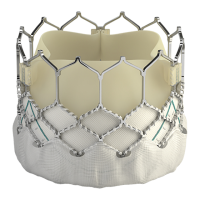5
o Blood dyscrasias defined as: leukopenia (WBC < 3000 cells/mL), acute anemia
(Hb < 9 g/dL), thrombocytopenia (platelet count < 50,000 cells/mL), or history of
bleeding diathesis or coagulopathy
o Hypertrophic cardiomyopathy with or without obstruction (HOCM)
o Echocardiographic evidence of intracardiac mass, thrombus, or vegetation
o A known hypersensitivity or contraindication to aspirin, heparin, ticlopidine (Ticlid™), or
clopidogrel (Plavix™), or sensitivity to contrast media, which cannot be adequately premedicated
o Significant aortic disease, including abdominal aortic or thoracic aneurysm defined as maximal
luminal diameter 5 cm or greater; marked tortuosity (hyperacute bend), aortic arch atheroma
(especially if thick [> 5 mm], protruding, or ulcerated) or narrowing (especially with calcification
and surface irregularities) of the abdominal or thoracic aorta, severe “unfolding” and tortuosity of
the thoracic aorta
o Access characteristics that would preclude safe placement of 14F or 16F Edwards eSheath
Introducer Set, such as severe obstructive calcification or severe tortuosity
o Bulky calcified aortic valve leaflets in close proximity to coronary ostia
6.0 Potential Adverse Events
Potential risks associated with the overall procedure including potential access complications associated
with standard cardiac catheterization, balloon valvuloplasty, the potential risks of conscious sedation
and/or general anesthesia, and the use of angiography:
• Death
• Stroke/transient ischemic attack, clusters or neurological deficit
• Paralysis
• Permanent disability
• Respiratory insufficiency or respiratory failure
• Hemorrhage requiring transfusion or intervention
• Cardiovascular injury including perforation or dissection of vessels, ventricle, myocardium or valvular
structures that may require intervention
• Pericardial effusion or cardiac tamponade
• Embolization including air, calcific valve material or thrombus
• Infection including septicemia and endocarditis
• Heart failure
• Myocardial infarction
• Renal insufficiency or renal failure
• Conduction system defect which may require a permanent pacemaker
• Arrhythmia
• Retroperitoneal bleed
• AV fistula or pseudoaneurysm
• Reoperation
• Ischemia or nerve injury
• Restenosis
• Pulmonary edema
• Pleural effusion

